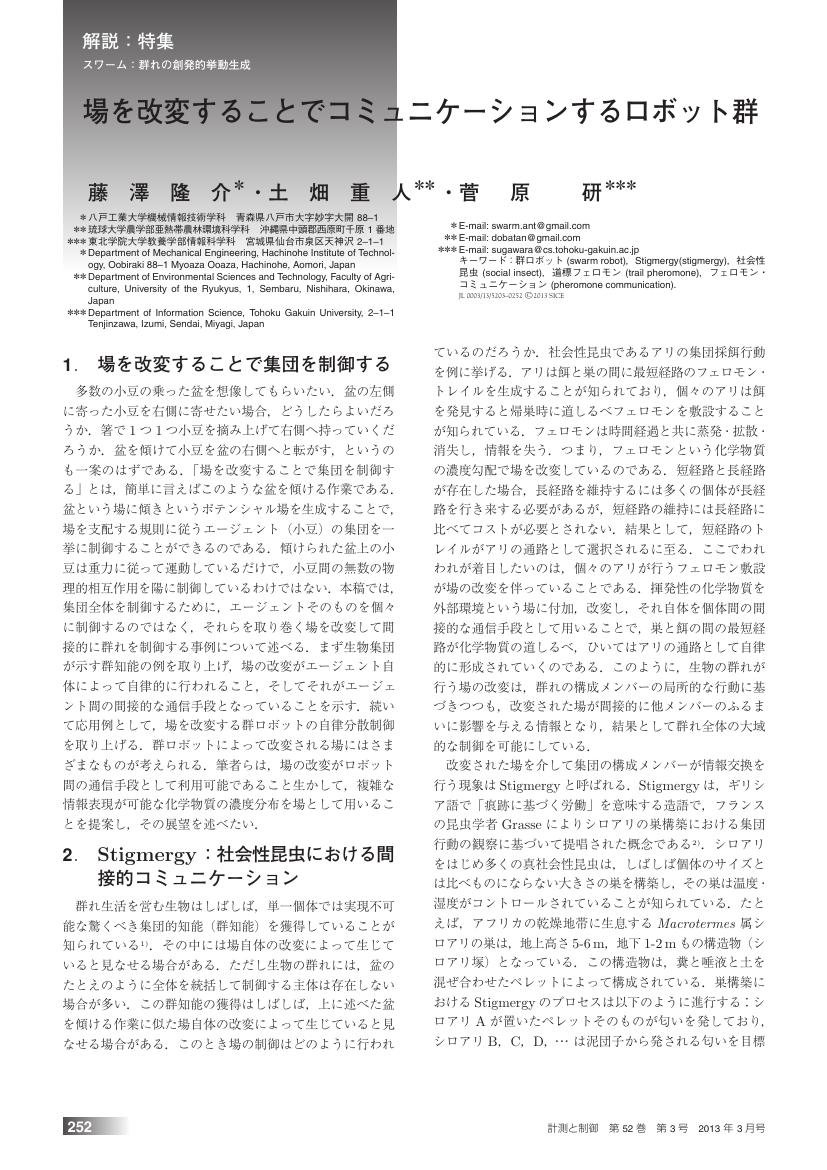2 0 0 0 OA ロボティクスと昆虫行動学の親和性
- 著者
- 藤澤 隆介 土畑 重人
- 出版者
- 一般社団法人 日本ロボット学会
- 雑誌
- 日本ロボット学会誌 (ISSN:02891824)
- 巻号頁・発行日
- vol.35, no.6, pp.459-462, 2017 (Released:2017-08-15)
- 参考文献数
- 21
1 0 0 0 OA 場を改変することでコミュニケーションするロボット群
- 著者
- 藤澤 隆介 土畑 重人 菅原 研
- 出版者
- 公益社団法人 計測自動制御学会
- 雑誌
- 計測と制御 (ISSN:04534662)
- 巻号頁・発行日
- vol.52, no.3, pp.252-257, 2013-03-10 (Released:2019-05-08)
- 参考文献数
- 26
1 0 0 0 OA 昆虫用運動補償装置を用いたオカダンゴムシの走光性の評価
- 著者
- 川野 雄基 大槻 圭一 阿部 真人 永谷 直久 志垣 俊介 藤澤 隆介
- 出版者
- 一般社団法人 システム制御情報学会
- 雑誌
- システム制御情報学会論文誌 (ISSN:13425668)
- 巻号頁・発行日
- vol.33, no.3, pp.67-76, 2020-03-15 (Released:2020-06-15)
- 参考文献数
- 18
In this study, we evaluated a phototaxis of pillbugs(Armadillidium vulgare) by using a behavior measurement system consisting of an omnidirectional motion compensation mechanism and a cylin-drical LED display. At the first, to validate the phototaxis of pillbugs against unidirectional light stimulation, we conducted an experiment under continuous light stimulation from one direction for 30 minutes. Subsequently, to evaluate phototaxis performance under the condition that the direction of light stimulus changes alternately, we experimented under three iteration cycles conditions (160 s, 40 s, 10 s). Our results revealed that the pillbugs moved significantly in the direction of weak light intensity, and it suggested that the pillbugs has negative phototaxis. Moreover, we showed that the negative phototaxis became the strongest when the iteration cycle is 160 s, and the negative phototaxis tended to weaken as the iteration cycle became shorter. Also, when the iteration cycle is 10 s, an increase in residence time is found, suggesting that does not necessarily take the routine response behavior according to the situation.
1 0 0 0 OA 2012年度論文賞の受賞論文紹介:環境に情報を残すロボティクスを研究すること
1 0 0 0 フェロモン・コミュニケーションによるロボット群の協調運搬
- 著者
- 藤澤 隆介 今村 光 松野 文俊
- 雑誌
- 研究報告数理モデル化と問題解決(MPS)
- 巻号頁・発行日
- vol.2011, no.9, pp.1-6, 2011-05-10
蟻は,フェロモン用いてコミュニケーションすることが知られており,その社会は高度に洗練されている.このコミュニケーションは,フェロモン・コミュニケーションと呼ばれている.群れは,個体の内部状態を遷移させることによって総体の状態を複雑に変化させることができ,外的な問題に対して柔軟に対応する.本論文では,我々はロボット群に焦点を当て,そのロボット群が化学物質を用いて協調運搬を実現する.新規に設計した群行動アルゴリズムによって現実のロボット群は餌を蟻の巣に模した場所まで協調運搬する.我々は,ロボット群が餌を発見して巣に持ち帰るまでの時間 (タスク解決時間) に注目し実験をした.その結果,環境中の個体密度が低いときにフェロモン・コミュニケーションが有効に働くことを発見した.Ants communicate with each other using pheromones, and their society is highly sophisticated. When foraging, they transport cooperatively with interplay of forces. The swarm is robust against changes in internal state, and shows flexibility in dealing with external problems. In this brief paper, we focus on the robot swarm that achieves cooperative transportation making use of ethanol as a substantial artificial pheromone. We also propose a swarm system with a newly developed algorithm that enables cooperative transportation of real robots. They will transport food to the nest analogous to the behaviour of a swarm of ants. Emphasis will be placed on the systematic task solution process. As the result, we found when low individual density, pheromone communication is effective.

